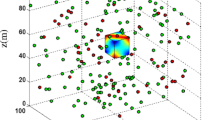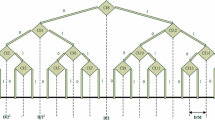Abstract
Location estimation is essential in any Wireless Sensor Network (WSN). A novel range-free localization approach has been proposed in this research that is based on multidimensional support vector regression (MSVR). To solve the regression problem, in this research a new training method for MSVR is proposed. The proposed localization approach is formulated in such a manner that the unknown sensor node position is calculated by using the position information of known actuator node by using proximity measurements. The simulations for the proposed schemes are done for both anisotropic and isotropic networks and also for both 2-D and 3-D environments. The simulated results showed the excellent performance by the proposed schemes in various scenarios as compared with the already existing schemes.






Similar content being viewed by others
References
Mainwaring, A., Culler, D., Polastre, J., Szewczyk, R., & Anderson, J. (2002). Wireless sensor networks for habitat monitoring. In Proceedings of the 1st ACM international workshop on wireless sensor networks and applications (pp. 88–97).
Al-Turjman, F. M., Hassanein, H. S., Alsalih, W. M., & Ibnkahla, M. (2011). Optimized relay placement for wireless sensor networks federation in environmental applications. Wireless Communications and Mobile Computing, 11(12), 1677–1688.
Hoffmann, G. M., & Tomlin, C. J. (2010). Mobile sensor network control using mutual information methods and particle filters. IEEE Transactions on Automatic Control, 55(1), 32–47.
Lee, S.-M., Cha, H., & Ha, R. (2007). Energy-aware location error handling for object tracking applications in wireless sensor networks. Computer Communications, 30(7), 1443–1450.
Zhu, Y., & Ni, L. M. (2016). A probabilistic approach to statistical QoS provision of event detection in sensor networks. Wireless Networks, 22(2), 439–451.
Zheng, J., Huang, Y., Wang, Y., & Xiao, Y. (2014). Deterministic deployment based on information coverage in wireless sensor networks. Wireless Communications and Mobile Computing, 14(18), 1657–1671.
Mao, G., Fidan, B., & Anderson, B. D. O. (2007). Wireless sensor network localization techniques. Computer Networks, 51(10), 2529–2553.
Niculescu, D., & Nath, B. (2003). DV based positioning in ad hoc networks. Telecommunication Systems, 22(1–4), 267–280.
Lee, S., Park, C., Lee, M. J., & Kim, S. (2014). Multihop range-free localization with approximate shortest path in anisotropic wireless sensor networks. EURASIP Journal on Wireless Communications and Networking, 2014(1), 1–12.
Xing, T., Wang, J., Chang, L., Chen, X., Fang, D., & Wu, C. Q. (2014). Link sensing-adaptive passive object localization in wireless sensor networks. International Journal of Distributed Sensor Networks, 2014.
Shilton, A., Sundaram, B., & Palaniswami, M. (2008). Ad hoc wireless sensor network localization using support vector regression. In Proceedings of ICT Mobile Summit, Stock. Sweden, vol. 1012.
Wang, C., Chen, J., & Sun, Y. (2010). Sensor network localization using kernel spectral regression. Wireless Communications and Mobile Computing, 10(8), 1045–1054.
He, X., Xiao, Y., & Wang, Y. (2011). A LSSVR three-dimensional WSN nodes location algorithm based on RSSI. In 2011 international conference on electrical and control engineering (ICECE) (pp. 1889–1895).
Staniec, K., & Debita, G. (2012). Interference mitigation in WSN by means of directional antennas and duty cycle control. Wireless Communications and Mobile Computing, 12(16), 1481–1492.
Shang, Y., Rumi, W., Zhang, Y., & Fromherz, M. (2004). Localization from connectivity in sensor networks. IEEE Transactions on Parallel and Distributed Systems, 15(11), 961–974.
Smola, A. J., & Schölkopf, B. (2004). A tutorial on support vector regression. Statistics and Computing, 14(3), 199–222.
Bulusu, N., Heidemann, J., & Estrin, D. (2001). Adaptive beacon placement. In 21st international conference on distributed computing systems, 2001 (pp. 489–498).
He, T., Huang, C., Blum, B. M., Stankovic, J. A., & Abdelzaher, T. (2003). Range-free localization schemes for large scale sensor networks. In Proceedings of the 9th annual international conference on mobile computing and networking (pp. 81–95).
Liu, J., Wang, Z., Yao, M., & Qiu, Z. (2015). VN-APIT: Virtual nodes-based range-free APIT localization scheme for WSN. Wireless Networks, 22, 1–12.
Lim, H., & Hou, J. C. (2005). Localization for anisotropic sensor networks. In INFOCOM 2005. 24th annual joint conference of the IEEE computer and communications societies. Proceedings IEEE, (Vol. 1, pp. 138–149).
Huang, G.-B., Zhou, H., Ding, X., & Zhang, R. (2012). Extreme learning machine for regression and multiclass classification. IEEE Transactions on Systems, Man, and Cybernetics, Part B (Cybernetics), 42(2), 513–529.
Huang, G.-B., Zhu, Q.-Y., & Siew, C.-K. (2006). Extreme learning machine: Theory and applications. Neurocomputing, 70(1), 489–501.
De Brabanter, K., De Brabanter, J., Suykens, J. A. K., & De Moor, B. (2011). Approximate confidence and prediction intervals for least squares support vector regression. IEEE Transactions on Neural Networks, 22(1), 110–120.
Lopez, J., & Dorronsoro, J. R. (2012). Simple proof of convergence of the SMO algorithm for different SVM variants. IEEE Transactions on Neural Networks and Learning Systems, 23(7), 1142–1147.
Bellocchio, F., Ferrari, S., Piuri, V., & Borghese, N. A. (2012). Hierarchical approach for multiscale support vector regression. IEEE Transactions on Neural Networks and Learning Systems, 23(9), 1448–1460.
Tran, D. A., & Nguyen, T. (2008). Localization in wireless sensor networks based on support vector machines. IEEE Transactions on Parallel and Distributed Systems, 19(7), 981–994.
Samadian, R., & Noorhosseini, S. M. (2011). Probabilistic support vector machine localization in wireless sensor networks. ETRI Journal, 33(6), 924–934.
Huan, R., Chen, Q., Mao, K., & Pan, Y. (2010) A three-dimension localization algorithm for wireless sensor network nodes based on SVM. In 2010 international conference on green circuits and systems (ICGCS), (pp. 651–654).
Ypma, T. J. (1995). Historical development of the Newton–Raphson method. SIAM Review, 37(4), 531–551.
Mehrotra, S. (1992). On the implementation of a primal-dual interior point method. SIAM Journal on Optimization, 2(4), 575–601.
Chapelle, O. (2007). Training a support vector machine in the primal. Neural Computation, 19(5), 1155–1178.
Boyd, S., & Vandenberghe, L. (2004). Convex optimization. Cambridge: Cambridge University Press.
Author information
Authors and Affiliations
Corresponding author
Rights and permissions
About this article
Cite this article
Anand, N., Ranjan, R. & Varma, S. MSVR Based Range-Free Localization Technique for 3-D Sensor Networks. Wireless Pers Commun 97, 6221–6238 (2017). https://doi.org/10.1007/s11277-017-4835-6
Published:
Issue Date:
DOI: https://doi.org/10.1007/s11277-017-4835-6




